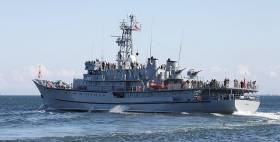Displaying items by tag: Polish Navy
Polish Navy Makes Rare Call with Trainee Schoolship
#PolishNavy - A Polish Navy vessel is to make a rare visit to Ireland, as the trainee schoolship is heading to Dublin Port this morning, writes Jehan Ashmore.
The trainee vessel ORP Wodnik (251) arrived in Dublin Bay to pick up pilot from cutter, Liffey. The naval visitor is to be taken into port to Ocean Pier and remain on a three-day courtesy call.
On board are 156 personnel, of those 56 are crew and the balance are from the cadet school. During the Gulf War, the vessel was rebuilt to serve as an evacuation hospital ship.
ORP Wodnik was launched by the Northern Shipyard in Gdansk in 1976. The 77m long vessel has a full displacement of 1745 tons and has an armament of a bow mounted single double cannon. Aft of the twin funnels are a pair of double guns.
She is one of a trio of such vessels of the Polish Navy whose ships names have the prefix ORP (Okręt Rzeczypospolitej Polskiej) which translates to the Ship of the Polish Republic.
The other trainee pair are the ORP Gryf also a frigate and which too entered service in 1976 and ORP Iskra. This sailing ship is no stranger to these shores, given she has taken part in Tall Ships Races down the years.
Poland is a member of the North Atlantic Treaty Organisation (NATO) which earlier this month held a major two-day summit in the Polish capital of Warsaw, attended by US President Barack Obama.
The head of the Polish Defence Ministry discussed the enhancement of the eastern flank of NATO and the decision to deploy four robust battalions in Poland and the Baltic States.
European Naval Flotilla Docks in Dublin
Of the foursome, only ENS Tasuja is the odd one out, she is a diving and support vessel whereas the rest are all a combination of minehunters / minesweepers. ENS Tasuja is from the Lindormen-class and was built in Denmark in 1977. She is 44.5 meters long, has a maximum speed of 14 knots, and has a crew of 28.
HNoMS Maaloey is an Oksøy-class minehunter which has a catamaran hull constructed of fibre-reinforced plastic which has a very low magnetic signature. She can carry two ROV's and the same number of rigid inflatable boats (RIB).
Above: The Norwegian Navy’s catamaran minehunter HNoMS Maaloey detonates a sea-mine
She is almost identical to the Alta-class leadship HNoMS Alta which provided escort duties during the official state visit of King Harald V and Queen Sonja of Norway, on board the royal yacht K/S Norge in 2006. She arrived in Irish waters, firstly calling to Dun Laoghaire Harbour, where the royal couple boarded the royal yacht at the East Pier. From there she sailed the short distance across the bay to Dublin Port and her last Irish call was to Cork.
ORP Flaming is a mine countermeasures vessel which operates in minesweeping and minehunting. The vessel is designed to trace such devices and make safe fairways for shipping. She can detect anchored mines 1600m from the ship and bottom mines located 600m below the ship's keel. In addition she can lay mines of six different types.
FGS Überherrn is a Kulmbach Class minehunter, in service with the German Navy since commissioning in 1989. She was originally built as a Hameln Class (SM 343) minesweeper by STN Systemtechnik Nord, but was converted to the Kulmbach Class. She has an overall length of 54.4m, a width of 9.2m and a draft of 2.5m and a displacement of 635 tonnes. Armament comprises two, four-cell Stinger missile launchers firing FIM-92 Stinger surface-to-air missiles. There are a crew of 37, which includes four officers, 20 petty officers and 13 ratings.
The flotilla are moored two abreast alongside Sir John Rogersons Quay (berth No. 8), which is located on the south quays between the Samuel Beckett and East-Link Bridges. Of the four naval ships, FGS Überherrn is the first to depart on Sunday, the other vessels are to depart on Monday. The vessels will provide an opportunity to view at close quarters a variety of naval architecture design and navies from northern Europe.






























































